In the electrical and electronics world, there are many cases where mishap takes place. It will lead to severe damage to building, offices, houses, schools, industries, etc. Trusting voltage and current are not correct, though safety measures are taken. Once circuit breakers are installed it will control the sudden rise of voltage and current. It will help from any accident. Circuit breakers are like the heart of the electrical system. There are different types of circuit breakers where these are installed according to the rating of the system. In house different kind of circuit breaker is used and for industries another type of circuit breaker is used. Let us discuss the different types of circuit breakers and its importance in detail.
What is a Circuit Breaker?
Electrical circuit breaker is a switching device which can be operated automatically or manually for protecting and controlling of electrical power system. In the modern power system the design of the circuit breaker has changed depending upon the huge currents and to prevent from arc while operating.

Electricity which is coming to the houses or offices or schools or industries or to any other places from the power distribution grids forms a large circuit. Those lines which are connected to the power plant forming at one end is called the hot wire and the other lines connecting to ground forming other end. Whenever the electrical charge flows between these two lines it develops potential between them. For the complete circuit the connection of loads (appliances) offers resistance to the flow of charge and the whole electrical system inside the house or industries will work smoothly.
They work smoothly as long as the appliances have sufficiently resistant and do not cause any over current or voltage. The reasons for heating up the wires are too much charge flowing through the circuit or short circuiting or sudden connection of the hot end wire to the ground wire would heat up the wires, causing fire. The circuit breaker will prevent such situations which simply cut off the remaining circuit.
Different Types of Circuit Breakers
The different types of high voltage circuit breakers which includes the following
- Air Circuit Breaker
- SF6 Circuit Breaker
- Vacuum Circuit Breaker
- Oil Circuit Breaker
- Air Circuit Breaker
Air Circuit Breaker
This circuit breaker will operate in the air; the quenching medium is an Arc at atmospheric pressure. In many of the countries air circuit breaker is replaced by oil circuit breaker. About oil circuit breaker we will discuss later in the article. Thus the importance of ACB is still preferable choice to use an Air circuit breaker up to 15KV. This is because; oil circuit breaker may catch fire when used at 15V
The two types of air circuit breakers are
- Plain air circuit breaker
- Air blast Circuit Breaker
Plain Air Circuit Breaker
Plain air circuit breaker is also called as Cross-Blast Circuit Breaker. In this, the circuit breaker is fitted with a chamber which basically surrounds the contacts. This chamber is known as arc chute.
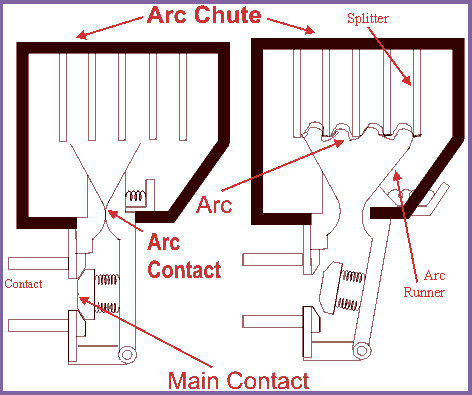
This arc is made to drive in it. In achieving the cooling of the air circuit breaker, an arc chute will help. From the refractory material, an arc chute is made. The internal walls of arc chute are shaped in such a way that arc is not forced into close proximity. It will drive into the winding channel projected on an arc chute wall.
The arc chute will have many small compartments and has many divisions which are metallic separated plates. Here each of small compartments behaves as a mini arc chute and metallic separation plate acts like arc splitters. All arc voltages will be higher than the system voltage when the arc will split into a series of arcs. It is only preferable for low voltage application.
Air Blast Circuit Breaker
Air blast circuit breakers are used for system voltage of 245 KV, 420 KV and also even more.Air blast circuit breakers are of two types:
- Axial blast breaker
- Axial blast with sliding moving contact.
Axial Blast Breaker
In the axial blaster breaker the moving contact of the axial blast breaker will be in contact. The nozzle orifice is a fixed to the contact of a breaker at a normal closed condition. A fault occurs when high pressure is introduced into the chamber. Voltage is sufficient to sustain high-pressure air when flowed through nozzle orifice.
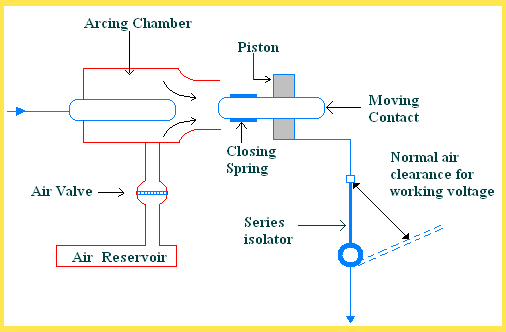
Advantages of Air-Blast Circuit Beaker
- It is used where frequent operation is required because of lesser arc energy.
- It is risk free from fire.
- Small in size.
- It requires less maintenance.
- Arc quenching is much faster
- Speed of circuit breaker is much higher.
- The time duration of the arc is same for all values of current.
Disadvantages of Air-Blast Circuit Breaker
- It requires additional maintenance.
- The air has relatively lower arc extinguishing properties
- It contains high capacity air compressor.
- From the air pipe junction there may be a chance of air pressure leakage
- There is the chance of a high rate rise of re-striking current and voltage chopping.
Application and Uses of Air Circuit Breaker
- It is used for protection of plants, electrical machines, transformers, capacitors and generators
- Air circuit breaker is also used in the Electricity sharing system and GND about 15Kv
- Also used in Low as well as High Currents and voltage applications.
SF6 Circuit Breaker
In the SF6 circuit breaker the current carrying contacts operate in sulphur hexafluoride gas is known as an SF6 circuit breaker. It is an excellent insulating property and high electro-negativity. It can be understood that, high affinity of absorbing free electron. The negative ion is formed when a free electron collides with the SF6 gas molecule; it is absorbed by that gas molecule. The two different ways of attachment of electron with SF6 gas molecules are
SF6 + e = SF6
SF6 + e = SF5- + F
SF6 + e = SF5- + F
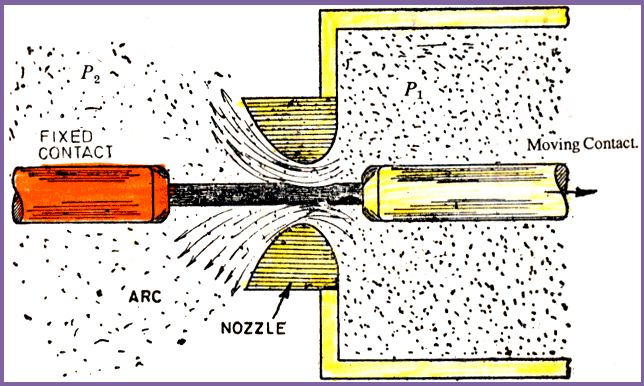
The negative ions which are formed will be much heavier than a free electron. Therefore, when compared with other common gases overall mobility of the charged particle in the SF6 gas is much less. The mobility of charged particles is majorly responsible for conducting current through a gas. Hence, for heavier and less mobile charged particles in SF6 gas, it acquires very high dielectric strength. This gas good heat transfer property because of low gaseous viscosity. SF6 is 100 times more effective in arc quenching media than air circuit breaker. It is used for both medium and high voltage electrical power system from 33KV to 800KV.
Types of SF6 Circuit Breaker
- Single interrupter SF6 circuit breaker applied up to 220
- Two interrupter SF6 circuit breaker applied up to 400
- Four interrupter SF6 circuit breaker applied up to 715V
Vacuum Circuit Breaker
A Vacuum circuit breaker is a circuit which vacuum is used to extinct the arc. It has dielectric recovery character, excellent interruption and can interrupt the high frequency current which results from arc instability, superimposed on the line frequency current.
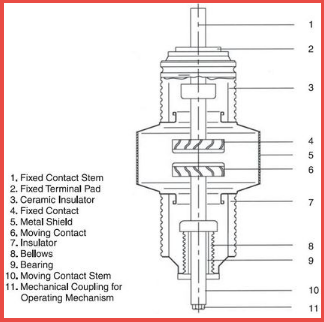
In the principle of operation of VCB will have two contacts called electrodes will remain closed under normal operating conditions. Suppose when a fault occurs in any part of the system, then the trip coil of the circuit breaker gets energized and finally contact gets separated.
The moment contacts of the breaker are opened in vacuum, i.e. 10-7 to 10-5 Torr an arc is produced between the contacts by the ionization of metal vapors of contacts. Here the arc quickly gets extinguished, this happens because the electrons, metallic vapors and ions produced during arc, condense quickly on the surface of the CB contacts, resulting in quick recovery of dielectric strength.
Advantages
- VCBs are reliable, compact and long life
- They can interrupt any fault current.
- There will be no fire hazards.
- No noise is produced
- It has higher dielectric strength.
- It requires less power for control operation.
Oil Circuit Breaker
In this type of circuit breaker oil is used, but mineral oil is preferable. It acts better insulating property than air. The moving contact and fixed contact are immerged inside the insulating oil. When the separation of current takes place, then carrier contacts in the oil, the arc in circuit breaker is initialized at the moment of separation of contacts, and because of this arc in the oil is vaporized and decomposed in hydrogen gas and finally creates a hydrogen bubble around the arc.
This highly compressed gas bubble around and arc prevents re-striking of the arc after current reaches zero crossing of the cycle. The OCB is the oldest type of circuit breakers.
Different types of Oil Circuit Breaker
- Bulk oil circuit breaker
- Minimum oil circuit breaker
Bulk Oil Circuit Breaker (BOCB)
In the BOCB, oil is used to arc the quenching media and also for insulating media in between earth parts of circuit breaker and current carrying contacts. The same transformer insulating oil is used.
The working principle of the BOCB says when the current carrying contacts in the oil are separated, then an arc is generated between the separated contacts. The arc which is established will produce rapid growing gas bubble around the arc. The moving contacts will move away from the fixed contact of arc and this result the resistance of the arc gets increased. Here the increased resistance will cause the lowering the temperature. Hence the reduced formations of gasses surround the arc.
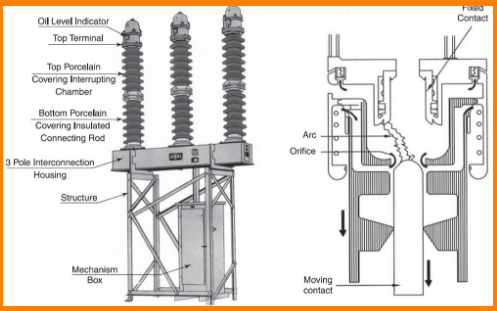
When the current passes through zero crossing the arc quenching in the BOCB takes places. In the totally air tight vessel, the gas bubble is enclosed inside the oil. The oil will surround with high pressure on the bubble, this results in highly compressed gas around the arc. When the pressure is increased the de- ionization of the gas also increases, which results in arc quenching. The hydrogen gas will help in cooling the arc quenching in the oil circuit breaker.
Advantages
- Good cooling property because of decomposition
- Oil has high dielectric strength
- It acts like an insulator between earth and live parts.
- The oil used here will absorb arc energy while decomposing
Disadvantages
- It will not permit high speed of interruption
- It takes long arcing time.
Minimum Oil Circuit Breaker
It is a circuit breaker which utilizes oil as the interrupting media. The minimum oil circuit breaker will place the interrupting unit in an insulating chamber at the live potential. But insulating material is available in interrupting chamber. It requires less amount of oil so it is called as minimum oil circuit breaker.
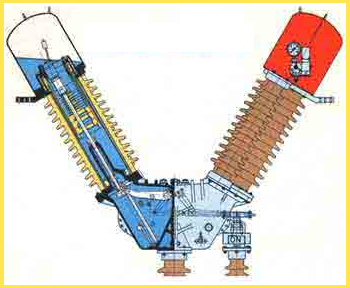
Advantages
- It requires less maintenance.
- It is suitable for both automatic operation and manual.
- It requires smaller space
- The cost for breaking capacity in MVA is also less.
Disadvantages
- Oil deteriorates because of carbonization.
- There is a possibility of explosion and fire
- As it has a smaller quantity of oil, so carbonization increases.
- It is very difficult to remove gases from the space between the contacts.
In this article the different types of circuit breakers, i.e. Air Circuit Breaker, SF6 Circuit Breaker, Vacuum Circuit Breaker and Oil Circuit Breaker have been discussed in a short detailed just to understand the basic concept about these circuit breakers. And their subdivision is also discussed along with advantages and disadvantages. We have discussed every concept very clearly.
By📝 :Chhatramani yadav


Thanks for your superb post. You can get these services here.
ReplyDeleteClipping path Photoshop |
Clipping Mask
Wow A nice character of mine. A good sheep leader .
ReplyDeleteindesign cs6 | clipping mask indesign
Very informative article. Thanks for the share.
ReplyDeletephotoshop mask | mask making